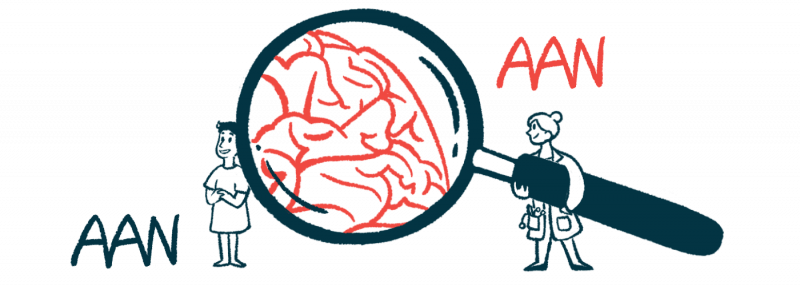#AAN2022 – Spinraza Showing Safety in Children With Needs After Zolgensma

Treatment with Spinraza (nusinersen) appears safe in infants and children with spinal muscular atrophy (SMA) who responded poorly to the gene therapy Zolgensma, early safety data from the first nine RESPOND trial patients show.
Motor and lung function were the most common domains showing disease progression despite Zolgensma treatment in these children. As of the study’s August 2021 data cutoff, none of the trial’s reported adverse events were considered to be related to Spinraza’s use.
The trial is currently recruiting SMA patients, up to 3 years of age, at sites in the U.S., Italy, Germany, Spain, and Israel; more information can be found here.
These preliminary findings were presented in a Biogen-funded poster at the 2022 American Academy of Neurology Annual Meeting, held in Seattle on April 2–7, and virtually on April 24–26.
The poster was titled “Baseline Characteristics and Initial Safety Results in RESPOND: A Phase 4 Study of Nusinersen in Children with Spinal Muscular Atrophy (SMA) Who Received Onasemnogene Abeparvovec.”
SMA is caused by low to no levels of the SMN protein due to mutations in the SMN1 gene. Motor neurons, the specialized nerve cells that control voluntary movement, are particularly sensitive to SMN deficiency, dying as a result.
Biogen’s Spinraza and Novartis’ Zolgensma (onasemnogene abeparvovec-xioi) are two approved disease-modifying therapies for SMA that increase SMN levels through different mechanisms.
While Spinraza boosts SMN production by targeting SMN2, a backup gene that can partially compensate for the loss of SMN1-derived SMN, the gene therapy Zolgensma uses a modified and harmless virus to deliver a working copy of SMN1 to cells.
Spinraza, given directly into the spinal canal every four months following four loading doses, is approved for children and adults with all SMA types.
Zolgensma, administered directly into the bloodstream through a single infusion, is available in the U.S. and Japan for children up to age 2, and in Europe for those with nearly all SMA types and weighing up to 21 kilograms (about 46 pounds).
While Zolgensma is expected to promote sustained SMN production in cells like motor neurons, previous preclinical research suggests that the therapy may target only a subset of these cells.
As such, the single-dose therapy may not always provide the intended therapeutic effect, and additional approaches may be needed.
According to real-world and clinical reports, some children treated with Zolgensma have subsequently received Spinraza, but no study to date has systematically analyzed the safety and clinical outcomes of such a combination.
To clarify Spinraza’s safety and effectiveness following Zolgensma, Biogen launched the Phase 4 RESPOND trial (NCT04488133), which aims to enroll up to 60 infants and children with SMA, ages 3 months to 3 years, who showed suboptimal responses to Zolgensma.
Their unmet clinical needs may include mild improvements in motor skills, a need for temporary respiratory support, swallowing or feeding difficulties abnormal for the patient’s age, or other responses not up to the standard considered relevant by the investigator.
Phase 4 trials are those beginning after a medicine has been approved by regulators and are usually conducted to check a therapy’s performance in real life.
Eligible patients must have received Zolgensma’s single dose at least three months before initiating Spinraza treatment, which will be given for up to two years.
The trial will have two study groups. One is expected to include 40 infants up to 9 months old, who carry two SMN2 gene copies (suggestive of type 1 disease) and given Zolgensma after symptom onset but before 6 months of age.
This group is meant to explore Spinraza’s effects among younger patients with a shorter mean interval between the two therapies.
The other group will include 20 children up to 3 years of age.
RESPOND’s main goal is to assess changes in the children’s ability to achieve certain motor milestones — such as head control, sitting, crawling, standing, and walking. Secondary goals include other validated motor function measures, time to death or permanent ventilation, and safety.
Newly presented data concerned the first nine enrolled children (five boys and four girls) who were followed for a median of 64 days (about two months) and up to six months as of Aug. 16, 2021.
All but one had two SMN2 gene copies. They were treated with Zolgensma at a median age of 2.7 months (range, 1.2–17.2 months) and started with Spinraza at a median age of 16.4 months (range, 5.1 to 30.4 months, or about 2.5 years).
At enrollment, all children showed suboptimal clinical response in at least two domains. Motor function was the most common (eight children), followed by lung function (six children), and swallowing/feeding skills (five children).
One child left the study’s at a parent or guardian’s request.
Safety data showed adverse events in six children (67%), with all mild to moderate in severity. Those most commonly reported included infections (44.4%) and vomiting (22.2%).
Two children experienced serious adverse events (all infections), which were successfully treated and did not prevent continued Spinraza dosing. No adverse event or serious adverse event was considered related to Spinraza’s use.
These early findings highlighted suboptimal clinical responses “in multiple domains including motor and respiratory functions despite [Zolgensma] treatment,” and suggested a favorable safety profile for subsequent treatment with Spinraza, the researchers wrote.
“Results from the RESPOND study will provide valuable information on the efficacy and safety of [Spinraza] in children with SMA who previously received [Zolgensma],” the researchers added, and could help to inform future treatment decisions for infants and young children with SMA.
Half of this poster’s 12 researchers are Biogen employees.
The SMA News Today team is providing coverage of the American Academy of Neurology (AAN) 2022 Annual Meeting.
The post #AAN2022 – Spinraza Showing Safety in Children With Needs After Zolgensma appeared first on SMA News Today.




